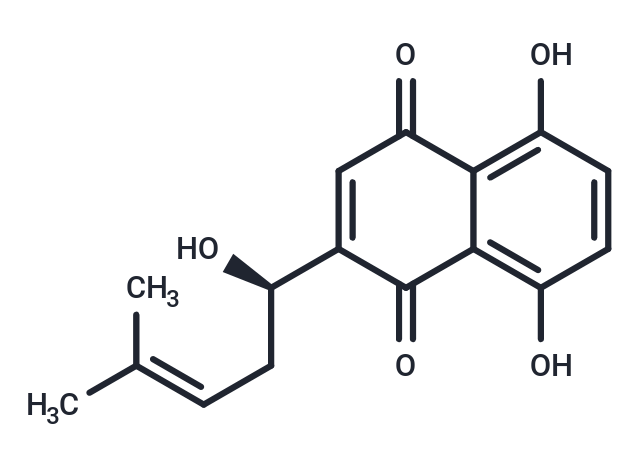Shopping Cart
- Remove All
 Your shopping cart is currently empty
Your shopping cart is currently empty

Shikonin (Anchusa acid) is a natural product, a TMEM16A chloride channel inhibitor (IC50=6.5 μM) and selective PKM2 inhibitor. Shikonin exhibits antitumor, anti-inflammatory and wound healing activities.

| Pack Size | Price | Availability | Quantity |
|---|---|---|---|
| 5 mg | $29 | In Stock | |
| 10 mg | $44 | In Stock | |
| 25 mg | $89 | In Stock | |
| 50 mg | $143 | In Stock | |
| 100 mg | $226 | In Stock | |
| 200 mg | $336 | In Stock | |
| 500 mg | $562 | Backorder | |
| 1 mL x 10 mM (in DMSO) | $48 | In Stock |
| Description | Shikonin (Anchusa acid) is a natural product, a TMEM16A chloride channel inhibitor (IC50=6.5 μM) and selective PKM2 inhibitor. Shikonin exhibits antitumor, anti-inflammatory and wound healing activities. |
| Targets&IC50 | PKM2 (FBP absence):0.3 μM, PKM2 (FBP presence):0.8 μM, TMEM16A (Cl- channel):6.5 μM |
| In vitro | METHODS: Human glioma cells U87 and U251 were treated with Shikonin (2.5-7.5 μmol/L) for 12-72 h. Cell viability was measured by CCK-8. RESULTS: Shikonin inhibited the proliferation of U87 and U251 cells in a time- and dose-dependent manner. [1] METHODS: Macrophages RAW264.7 were pretreated with Shikonin (0.5-2 μM) for 1 h, then treated with LPS (250 ng/mL) and IFN-γ (100 ng/mL) for 24 h. Inflammatory factor levels were measured using RT-qPCR and ELISA. RESULTS: In LPS+IFN-γ-mimicked RAW264.7 cells, mRNA and protein expression of IL-1β, IL-6 and TNF-α were reduced. [2] |
| In vivo | METHODS: To investigate the efficacy against murine colitis, Shikonin (6.125-25 mg/kg) was administered by gavage to a DSS-induced Balb/c mouse model of colitis once daily for seven days. RESULTS: Shikonin attenuated the overall symptoms of DSS-induced colitis in mice and reduced colonic injury. [2] METHODS: To detect anti-tumor activity in vivo, Shikonin (0.1-10 mg/kg) was administered intraperitoneally to SCID mice bearing human melanoma B16 once daily for nine days. RESULTS: Shikonin treatment inhibited B16 cell growth in SCID mice in a dose-dependent manner. [3] |
| Cell Research | U87 and U251 cells are seeded into 96-well plates at a density of 1×104 cells per well in standard DMEM and incubated for 24 h under standard conditions (37°C and 5% CO2). Then the medium is replaced with either blank, serum-free DMEM or DMEM containing Shikonin at concentrations of 2.5, 5, and 7.5 μM. The total volume in each well is 200 μL. Finally, the plates are shaken softly and the optical density is recorded at 570 nm (OD570) using a plate reader. At least three independent experiments are performed[4]. |
| Animal Research | Healthy male Sprague-Dawley rats (n=30; 8 to 10-weeks old, 250 to 300 g) are used in this study. Rats were randomly assigned to three groups: Sham-operated group (n=10), osteoarthritis model group (n=10) and Shikonin-treated group (n=10). In the sham-operated group, the right knee joint of the anesthetized rat is only exposed under sterile conditions, and the rats are treated with 0.1 ml/100 g physiological saline (i.p.). In the osteoarthritis model group, osteoarthritis model rats were treated with 0.1 ml/100 g physiological saline (i.p.). In the Shikonin-treated group, osteoarthritis model rats are treated with 10 mg/kg Shikonin (i.p.) once daily for 4 days after osteoarthritis modeling[5]. |
| Alias | NSC 252844, Isoarnebin 4, C.I. 75535, Anchusa acid, Alkanna Red, (+)-Shikonin |
| Molecular Weight | 288.3 |
| Formula | C16H16O5 |
| Cas No. | 517-89-5 |
| Smiles | CC(C)=CC[C@@H](O)C1=CC(=O)c2c(O)ccc(O)c2C1=O |
| Relative Density. | 1.373g/cm3 |
| Storage | keep away from direct sunlight | Powder: -20°C for 3 years | In solvent: -80°C for 1 year | Shipping with blue ice. | |||||||||||||||||||||||||
| Solubility Information | DMSO: 57 mg/mL (197.71 mM), Sonication is recommended. H2O: Insoluble Ethanol: 13 mg/mL (45.09 mM), Sonication is recommended. 10% DMSO+40% PEG300+5% Tween 80+45% Saline: 5.7 mg/mL (19.77 mM), suspension.In vivo: Please add the solvents sequentially, clarifying the solution as much as possible before adding the next one. Dissolve by heating and/or sonication if necessary. Working solution is recommended to be prepared and used immediately. | |||||||||||||||||||||||||
Solution Preparation Table | ||||||||||||||||||||||||||
Ethanol/DMSO
DMSO
| ||||||||||||||||||||||||||

Copyright © 2015-2025 TargetMol Chemicals Inc. All Rights Reserved.